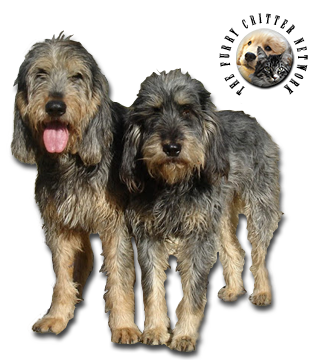Breed Standard
Head: Bony, fairly long, lightly boned but not small. Skull nearly flat. Slight stop. Straight nosebridge. Brow bones accentuated by bushy eyebrows. Beard on the chin. Very prominent nose.
Ears: Supple, moderately wide and long, slightly curled toward the tip.
Eyes: Preferably dark.
Body: Long. Neck fairly lightly boned, well-knit, without dewlap. Brisket not broad. Chest let down to elbow. Slight tuck-up. Level loin. Long back.
Tail: Not very long, carried in saber fashion, more tufted in the middle.
Hair: Long, thick, bushy, fairly strong, and hard. Neither woolly nor frizzy.
Coat: Preferably wolf grey or bluish-grey, boar grey, faded black, or salt and pepper, with tan markings on the cheeks, above the eyes, on the inner and lower legs, or fawn with a mixture of black and white hairs, creating a dark cast.
Size: Dog: 55 to 60 cm. (21.5-23.5 in).Bitch: 53 to 58 cm. (21-22.8 in).
Weight: Approx. 25kg (55 lb).
History
The Nivernais Griffon is one of the very old hound breeds used on wolves. His ancestors include the Chien Gris de Saint Louis, as well as Foxhounds and breeds from Auvergne, Vend e, and Bresse. Today's Nivernais Griffon was developed in the Morvan and Ni vre regions of France. A club for this breed was founded in 1925. After a critical period, the Nivernais Griffon has made a comeback and careful selection is improving the breed's structure, speed, and character.
Behavior
This wolf tracker of old is still a hardy, independent, enthusiastic hunter. Although the breed is now calmer and faster, it is still just as robust. The Nivernais Griffon's superb nose and remarkable voice also explain why he is so popular with hunters. He can be affectionate and a good companion, but he needs a firm owner.
He needs space and lots of exercise, as well as frequent combing and brushing.
Function
Hunting Dog, Pet.
Health
A very hearty and robust breed.






